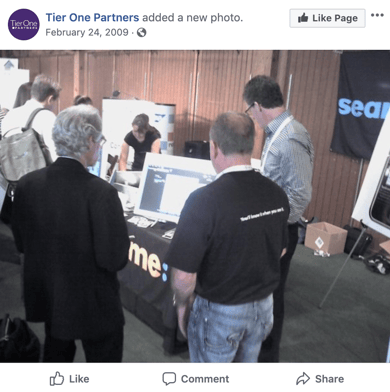TOP TALK
We Audited Our Social Media Accounts. It Was Awkward. But Here’s Why It's Important

Posted By Stephanie Malkus on December 12, 2019
If you’ve Googled “how to delete old tweets” recently, you’re not alone. As brands, celebrities, and athletes (also Milkshake Duck) can attest, old social media posts can come back to haunt you — big time.
The remedy? A little preparation, strategy, and self-reflection (i.e. a good, old-fashioned social audit). Otherwise, those who don’t know their social media history are doomed to repeat it (or something like that).
A thorough audit of your social accounts can not only keep your social profiles in fighting shape, it can help you improve processes and take your social content game to the next level. To prove our point, we tracked our own social audit (complete with the essential awkward photo), but first, let’s talk about what that audit includes.
The Power of the Audit
A long, hard look in the mirror may seem daunting, but we promise, it’s worthwhile (and should be a part of every marketer’s social routine and strategy). You’re probably not going to find anything too condemning (i.e. of the racist, sexist, or generally bigoted variety) on your profiles, but knowing how to review old posts could help you avoid the need for crisis communication.
Every audit will need to be tailored to the specific needs of that brand, but you should let these best practices guide you:
Have a Plan
Before you begin your journey to the past, plot out your goals. Do you want to identify what posts have done well in the past? Figure out which campaigns weren’t quite up to snuff? Or maybe you’re looking for ways to strengthen engagement?
Next, map out the steps you’ll take to get there. Decide which platform you’ll begin with (i.e. the one you’re most active on). And finally, determine exactly what insights/data points you’ll be collecting (post copy, publish dates, engagement, etc.) and decide on how/where you’ll organize the findings.
It’s Not All About Your Posts
While you’re scrolling through yesteryear, don’t forget to look beyond your posts. Other categories you may want to include in your audit:
- Competitive analysis
- Hot topic identification
- Profile refresh (or rebrand)
And don’t forget your thought leaders. For most brands, this is where you’re most likely to get caught with your foot in your mouth. It’s unlikely your CEO once tweeted something offensive, but it’s always good to confirm. Even if your thought leaders are using new, separate, professional accounts, do a thorough sweep of their channels and be prepared for all possible scenarios.
Which brings us to a philosophical quandary for our time: Should you delete old posts?
The short answer: Probably not. Rewriting history (or unwriting it, as it were) is not a good look for anyone. And because of caching, cookies, third-party apps, and countless other technological backups, deleting an old post doesn’t guarantee it’s gone. If there’s a post in your past you’re less than proud of, have a plan ready to go. (Note: Exceptions could include more highly regulated industries where compliance/legal issues exist.)
Now, proving that the payoff of a social audit is well worth the pain of wading through the awkward years, here are our own findings.
We practiced what we preach and started our audit with our most active social platform. The Tier One Twitter dates back to 2008, and, after going through all the posts, we identified some ways we’ve grown. For example, this share from a blizzardy, blustery Boston day back in 2013.

Six years later, the tone and message remains in line with the Tier One voice (pats self on back). What stands out as an area for improvement is the lack of image. It’s not worthy of a tweet delete, but a notable adjustment nonetheless.
Process Note: The soundbite-driven, fast-moving pace of Twitter likely means you’ll have more content to get through. If you’re manually scrolling back through your Twitter account, you’ll only be able to find your last 3,200 tweets, but a few tools can help you gain access to all your Twitter history:
For most brands, auditing LinkedIn is going to feel like a breeze after Twitter. The platform only grants access to the last year of posts, likely reducing the amount you need to scrutinize. And because it’s a professional social networking site, it’s unlikely to be the source of any major controversy. But that doesn’t mean there aren’t other findings to glean from a LinkedIn audit (and possible profile updates to take advantage of).
That’s why we took a different approach to our LinkedIn audit and focused on finding trends among the posts that performed really well. What we discovered might surprise you: Personal/company culture posts, like shares from Tier One service trips and other agency goings on, were by far our most consistently engaged posts. On the flip side, we noticed our lower performers lacked that personal connection — even something as simple as tagging the author of a blog post made a significant difference. It goes to show you that even on a professional platform, personal connections matter.
Process Note: LinkedIn allows pages to download the last year’s posts and all their engagement numbers from the analytics tab. Now you can sort, scan, and very quickly highlight top performers.
Though it’s by far the most populated platform, Facebook’s timeline format makes it fairly simple to review account and page history. So, it didn’t take us long to find this no-caption gem from a decade ago.

Times were simpler then, and we now know that captionless photos don’t pack a lot of punch on social media. Our big FB audit takeaway was the power of visual context: Pictures may be worth a thousand words, but sometimes you need an actual word or two to convey the larger point (and provide value for your audience).
Process Note: As noted above, seeing your history on Facebook offers additional audit opportunities the other platforms do not. Facebook lets you edit old posts and backdate content, but both actions will be noted on the posts you edit or backdate, so be transparent and tactful with both.
Tier One debuted on the ‘Gram in 2013, and with only 180 posts to our name, it was relatively simple to scroll back to the beginning. Here’s our first post.

Different brands have different strategies on Instagram. As a creative agency, we use Insta to showcase our visual prowess while also sharing more personal, behind-the-scenes content. And as you can see, our first post from 2013 did a good job setting the tone.
Process Note: If a post doesn’t fit your brand aesthetic anymore, you don’t have to delete it. (In fact, don’t.) Just archive it. It will no longer be visible on your profile, but you’ll still have it on hand should the right #TBT moment arise.
What We Learned
All in all, taking a step back to look at ourselves throughout the years was highly productive. It revealed areas we excel, where we’ve improved, and where we still have room for growth. The audit gave us peace of mind and motivation to do better. Any marketer who studies and learns from their past can create a stronger future for their brand.
If you think it’s time for an audit, but aren’t sure where to start, reach out to us. We’d love to learn more about your social history and how we can help you build a strong social future.




